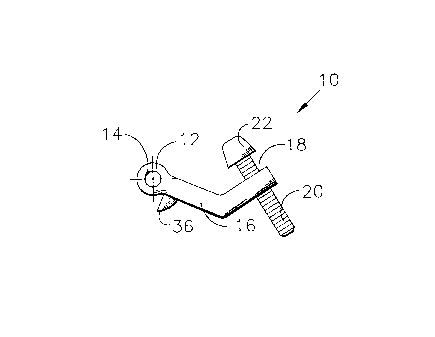Some of the information on this Web page has been provided by external sources. The Government of Canada is not responsible for the accuracy, reliability or currency of the information supplied by external sources. Users wishing to rely upon this information should consult directly with the source of the information. Content provided by external sources is not subject to official languages, privacy and accessibility requirements.
Any discrepancies in the text and image of the Claims and Abstract are due to differing posting times. Text of the Claims and Abstract are posted:
| (12) Patent: | (11) CA 2037950 |
|---|---|
| (54) English Title: | ADJUSTABLE DOOR STOP |
| (54) French Title: | BUTOIR DE PORTE, REGLABLE |
| Status: | Expired and beyond the Period of Reversal |
| (51) International Patent Classification (IPC): |
|
|---|---|
| (72) Inventors : |
|
| (73) Owners : |
|
| (71) Applicants : | |
| (74) Agent: | SMART & BIGGAR LP |
| (74) Associate agent: | |
| (45) Issued: | 2000-11-14 |
| (22) Filed Date: | 1991-03-11 |
| (41) Open to Public Inspection: | 1991-09-20 |
| Examination requested: | 1998-03-11 |
| Availability of licence: | N/A |
| Dedicated to the Public: | N/A |
| (25) Language of filing: | English |
| Patent Cooperation Treaty (PCT): | No |
|---|
| (30) Application Priority Data: | ||||||
|---|---|---|---|---|---|---|
|
An adjustable door stop for a hinge mounted door having at least
one hinge leaf connected to the door, one hinge leaf connected to a
doorway, and a hinge pin. A body receives the hinge pin in order to
rotate substantially perpendicular to the axis of the hinge pin. An
adjustable mechanism extends from the body and rests against the
doorway. A finger extends from the body substantially parallel to the
axis of the hinge pin so that the hinge leaf connected to the door may
rest against the finger, thereby stopping movement of the door.
Note: Claims are shown in the official language in which they were submitted.
Note: Descriptions are shown in the official language in which they were submitted.

2024-08-01:As part of the Next Generation Patents (NGP) transition, the Canadian Patents Database (CPD) now contains a more detailed Event History, which replicates the Event Log of our new back-office solution.
Please note that "Inactive:" events refers to events no longer in use in our new back-office solution.
For a clearer understanding of the status of the application/patent presented on this page, the site Disclaimer , as well as the definitions for Patent , Event History , Maintenance Fee and Payment History should be consulted.
| Description | Date |
|---|---|
| Inactive: Reversal of expired status | 2012-12-02 |
| Time Limit for Reversal Expired | 2011-03-11 |
| Letter Sent | 2010-03-11 |
| Inactive: IPC from MCD | 2006-03-11 |
| Inactive: IPC from MCD | 2006-03-11 |
| Grant by Issuance | 2000-11-14 |
| Inactive: Cover page published | 2000-11-13 |
| Inactive: Final fee received | 2000-08-08 |
| Small Entity Declaration Determined Compliant | 2000-08-08 |
| Pre-grant | 2000-08-08 |
| Notice of Allowance is Issued | 2000-06-01 |
| Notice of Allowance is Issued | 2000-06-01 |
| Letter Sent | 2000-06-01 |
| Inactive: Approved for allowance (AFA) | 2000-05-18 |
| Amendment Received - Voluntary Amendment | 2000-03-28 |
| Inactive: S.30(2) Rules - Examiner requisition | 2000-02-01 |
| Amendment Received - Voluntary Amendment | 1998-11-06 |
| Inactive: Application prosecuted on TS as of Log entry date | 1998-04-06 |
| Letter Sent | 1998-04-06 |
| Inactive: Status info is complete as of Log entry date | 1998-04-06 |
| All Requirements for Examination Determined Compliant | 1998-03-11 |
| Request for Examination Requirements Determined Compliant | 1998-03-11 |
| Application Published (Open to Public Inspection) | 1991-09-20 |
There is no abandonment history.
The last payment was received on 2000-03-01
Note : If the full payment has not been received on or before the date indicated, a further fee may be required which may be one of the following
Please refer to the CIPO Patent Fees web page to see all current fee amounts.
| Fee Type | Anniversary Year | Due Date | Paid Date |
|---|---|---|---|
| MF (application, 7th anniv.) - small | 07 | 1998-03-11 | 1998-01-21 |
| Request for examination - small | 1998-03-11 | ||
| MF (application, 8th anniv.) - small | 08 | 1999-03-11 | 1999-02-24 |
| MF (application, 9th anniv.) - small | 09 | 2000-03-13 | 2000-03-01 |
| Final fee - small | 2000-08-08 | ||
| MF (patent, 10th anniv.) - small | 2001-03-12 | 2001-02-20 | |
| MF (patent, 11th anniv.) - small | 2002-03-11 | 2002-02-21 | |
| MF (patent, 12th anniv.) - small | 2003-03-11 | 2003-02-24 | |
| MF (patent, 13th anniv.) - small | 2004-03-11 | 2004-02-20 | |
| MF (patent, 14th anniv.) - small | 2005-03-11 | 2005-02-21 | |
| MF (patent, 15th anniv.) - small | 2006-03-13 | 2006-02-17 | |
| MF (patent, 16th anniv.) - small | 2007-03-12 | 2007-02-19 | |
| MF (patent, 17th anniv.) - small | 2008-03-11 | 2008-02-18 | |
| MF (patent, 18th anniv.) - small | 2009-03-11 | 2009-02-17 |
Note: Records showing the ownership history in alphabetical order.
| Current Owners on Record |
|---|
| B. JACK SMITH |
| Past Owners on Record |
|---|
| None |